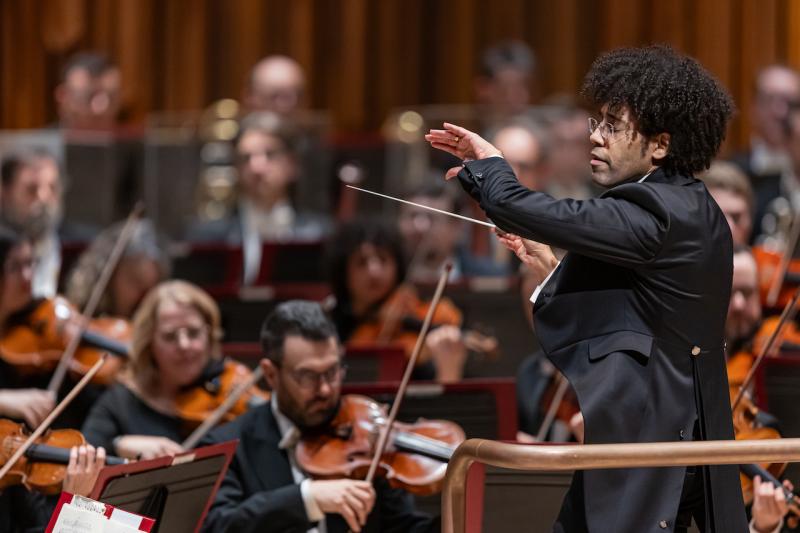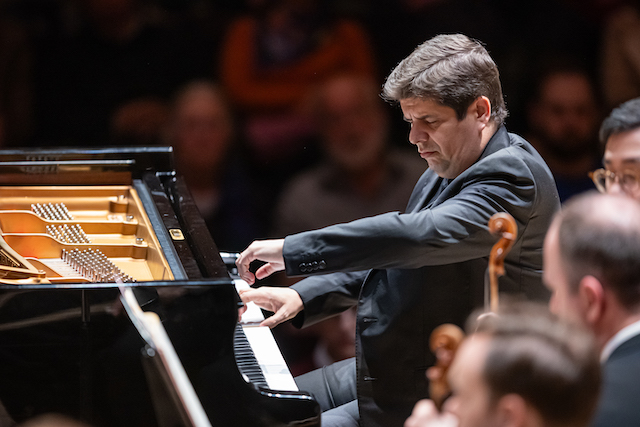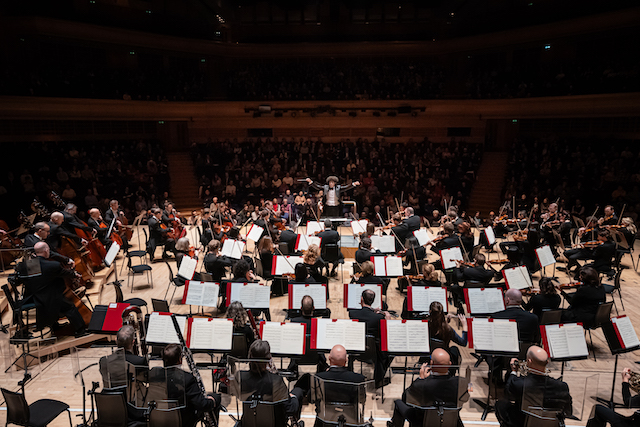Perianes, Orchestre Symphonique de Montréal, Payare, Barbican review - elegance and drama but not enough bite | reviews, news & interviews
Perianes, Orchestre Symphonique de Montréal, Payare, Barbican review - elegance and drama but not enough bite
Perianes, Orchestre Symphonique de Montréal, Payare, Barbican review - elegance and drama but not enough bite
Often dynamic Venezuelan conductor misses the darkness of the 'Symphonie fantastique'

When the Venezuelan Rafael Payare was appointed as conductor of the Orchestre Symphonique de Montréal (OSM) two years ago, his first action was to blast his way through a French Berlitz course.
Watching him conduct however – his tall angular frame sometimes hunched-bird-of-prey like on the podium, sometimes erupting into a nimble dance – it’s clear that Payare (main picture) has expressive powers that far transcend language. Over his years as a conductor he’s divided opinion – some hailing him for his electricity and dynamism, others worrying that he has a tendency to sacrifice speed for expressiveness – yet in the concert’s first half there was no doubt about the rapport he has with this superlatively streamlined orchestra.
The evening opened with Iranian-Canadian composer Iman Habibi’s Jeder Baum spricht (Every tree speaks) a response to Beethoven’s evocations of nature in Symphonies 5 and 6. Composed for the 250th anniversary of Beethoven’s birth in 2020, it’s a rousing evocation of a world thrown into chaos by climate change.
After an elemental opening led by double basses that quickly rose to a climax augmented by kettle drums, the orchestra launched into a Rite-of-Spring-like frenzy. Payare skilfully negotiated the transition between the frenetic passages and more lush lyrical interludes which seemed to evoke babbling mountain streams and sunlight slanting through trees. There were moments when the performance clearly conveyed the sense of a planet teetering on apocalypse and others when it felt as if we were in a rhapsodic Vaughan-Williamesque world. At the end of the thrilling finale, in which the entire orchestra shivered to a crescendo, the whole hall resounded with the piece’s explosive energy.
 Aptly we then had Beethoven to respond, but in place of Symphony 5 or 6 we had his Piano Concerto No 1. (Famously this is in fact his third concerto, following an abandoned teenage effort and the protracted years of experiment that led to what’s now described as his Piano Concerto No 2). Respected Spanish pianist Javier Perianes (pictured above – a replacement for Daniil Trifonov) took the helm for this with an ease and assurance that made it a sheer joy to listen to. His modest stage presence – in which he sat and listened to the orchestra for the introduction as if he were a member of the audience – was in counterpoint to the effortless brilliance with which he executed everything from the crisp demisemiquaver triplets to the shimmering arpeggiated sequences.
Aptly we then had Beethoven to respond, but in place of Symphony 5 or 6 we had his Piano Concerto No 1. (Famously this is in fact his third concerto, following an abandoned teenage effort and the protracted years of experiment that led to what’s now described as his Piano Concerto No 2). Respected Spanish pianist Javier Perianes (pictured above – a replacement for Daniil Trifonov) took the helm for this with an ease and assurance that made it a sheer joy to listen to. His modest stage presence – in which he sat and listened to the orchestra for the introduction as if he were a member of the audience – was in counterpoint to the effortless brilliance with which he executed everything from the crisp demisemiquaver triplets to the shimmering arpeggiated sequences.
Though there were points when it felt that Payare could have had more eye contact with Perianes, this was an elegant and beautifully modulated account of the concerto, with piano and orchestra deftly matching each other in tone and rhythm. The Mozartian influence was clear in the grace and supple humour of the OSM’s playing, but so too was the sense of rhetorical bite and dark rumbling undertones that Beethoven made so distinctively his own.
At moments Perianes’ playing was giddily joyful at others it was swooningly lyrical, as, for instance, at the start of the second Largo movement in which the notes resonated with a teardrop clarity. In the galloping final movement, Perianes brought out the full humour of passages jaunty enough to accompany a Harold Lloyd movie, before bringing a darker resonance to the finish. Throughout Payare’s control of the orchestra (pictured below) was both meticulous and ebullient. At the energetic orchestral approach to the piano’s final cadenza (which by contrast was richly introspective), he almost took off from the podium in his enthusiasm.
After the interval we had the programmatic highlight of the evening, Berlioz’s Symphonie fantastique, which the 26-year-old composer had dedicated somewhat disturbingly to the Irish actress Harriet Smithson. As the programme notes reminded us, he described the symphony itself as the recreation of an “opium dream” in which he dreamed that he had killed his love and was taken to the scaffold, only to be visited by her in a witches’ sabbath. Their subsequent marriage was a disaster.
 Throughout the evening Payare had proved himself as deft at creating moments of stillness as he was at stirring the orchestra to full frenzy. At the opening of the first Rêveries – Passions movement, the plaintive sweetness of the violins dominated before the playing became more agitated, escalating to tempest level by the end. In the Bal (Ball) movement, it felt as if we were sweeping round a ballroom with light glinting off the chandeliers. The Scène aux champs (Scene in the Countryside) movement was a pastoral delight, with the woodwind and strings seeming to evoke birdsong in trees swayed by a light breeze.
Throughout the evening Payare had proved himself as deft at creating moments of stillness as he was at stirring the orchestra to full frenzy. At the opening of the first Rêveries – Passions movement, the plaintive sweetness of the violins dominated before the playing became more agitated, escalating to tempest level by the end. In the Bal (Ball) movement, it felt as if we were sweeping round a ballroom with light glinting off the chandeliers. The Scène aux champs (Scene in the Countryside) movement was a pastoral delight, with the woodwind and strings seeming to evoke birdsong in trees swayed by a light breeze.
Yet the performance of these three movements was also so elegantly controlled that it was difficult to get a sense of the wild unhinged energy that underpinned Berlioz’s motivation for composing the music. Yes, there only needed to be a hint of this in the earlier movements, but they felt more champagne and canapés than opium dream.
It was in the more overtly macabre final movements – Marche au supplice (March to the Scaffold) and Sange d’une nuit du Sabbat that the drama truly became compelling. Not least during the infamous bells sequence – played here by two special commissioned church-style bells weighing in at 451kg – which lifted the whole performance to another dimension both musically and spiritually. Throughout this last movement Payare stirred the orchestra to a performance of rich colour, whether it was the double basses and tubas with their sonorous menace, or the violins rattling the bows on their strings so they sounded like dancing skeletons. Now that the OSM has invested in the bells, it will be interesting to see how this interpretation grows in future performances.
The future of Arts Journalism
You can stop theartsdesk.com closing!
We urgently need financing to survive. Our fundraising drive has thus far raised £49,000 but we need to reach £100,000 or we will be forced to close. Please contribute here: https://gofund.me/c3f6033d
And if you can forward this information to anyone who might assist, we’d be grateful.

Subscribe to theartsdesk.com
Thank you for continuing to read our work on theartsdesk.com. For unlimited access to every article in its entirety, including our archive of more than 15,000 pieces, we're asking for £5 per month or £40 per year. We feel it's a very good deal, and hope you do too.
To take a subscription now simply click here.
And if you're looking for that extra gift for a friend or family member, why not treat them to a theartsdesk.com gift subscription?
more Classical music
 Lammermuir Festival 2025, Part 2 review - from the soaringly sublime to the zoologically ridiculous
Bigger than ever, and the quality remains astonishingly high
Lammermuir Festival 2025, Part 2 review - from the soaringly sublime to the zoologically ridiculous
Bigger than ever, and the quality remains astonishingly high
 BBC Proms: Ehnes, Sinfonia of London, Wilson review - aspects of love
Sensuous Ravel, and bittersweet Bernstein, on an amorous evening
BBC Proms: Ehnes, Sinfonia of London, Wilson review - aspects of love
Sensuous Ravel, and bittersweet Bernstein, on an amorous evening
 Presteigne Festival 2025 review - new music is centre stage in the Welsh Marches
Music by 30 living composers, with Eleanor Alberga topping the bill
Presteigne Festival 2025 review - new music is centre stage in the Welsh Marches
Music by 30 living composers, with Eleanor Alberga topping the bill
 Lammermuir Festival 2025 review - music with soul from the heart of East Lothian
Baroque splendour, and chamber-ensemble drama, amid history-haunted lands
Lammermuir Festival 2025 review - music with soul from the heart of East Lothian
Baroque splendour, and chamber-ensemble drama, amid history-haunted lands
 BBC Proms: Steinbacher, RPO, Petrenko / Sternath, BBCSO, Oramo review - double-bill mixed bag
Young pianist shines in Grieg but Bliss’s portentous cantata disappoints
BBC Proms: Steinbacher, RPO, Petrenko / Sternath, BBCSO, Oramo review - double-bill mixed bag
Young pianist shines in Grieg but Bliss’s portentous cantata disappoints
 theartsdesk at the Lahti Sibelius Festival - early epics by the Finnish master in context
Finnish heroes meet their Austro-German counterparts in breathtaking interpretations
theartsdesk at the Lahti Sibelius Festival - early epics by the Finnish master in context
Finnish heroes meet their Austro-German counterparts in breathtaking interpretations
 Classical CDs: Sleigh rides, pancakes and cigars
Two big boxes, plus new music for brass and a pair of clarinet concertos
Classical CDs: Sleigh rides, pancakes and cigars
Two big boxes, plus new music for brass and a pair of clarinet concertos
 Waley-Cohen, Manchester Camerata, Pether, Whitworth Art Gallery, Manchester review - premiere of no ordinary violin concerto
Images of maternal care inspired by Hepworth and played in a gallery setting
Waley-Cohen, Manchester Camerata, Pether, Whitworth Art Gallery, Manchester review - premiere of no ordinary violin concerto
Images of maternal care inspired by Hepworth and played in a gallery setting
 BBC Proms: Barruk, Norwegian Chamber Orchestra, Kuusisto review - vague incantations, precise laments
First-half mix of Sámi songs and string things falters, but Shostakovich scours the soul
BBC Proms: Barruk, Norwegian Chamber Orchestra, Kuusisto review - vague incantations, precise laments
First-half mix of Sámi songs and string things falters, but Shostakovich scours the soul
 BBC Proms: Alexander’s Feast, Irish Baroque Orchestra, Whelan review - rapturous Handel fills the space
Pure joy, with a touch of introspection, from a great ensemble and three superb soloists
BBC Proms: Alexander’s Feast, Irish Baroque Orchestra, Whelan review - rapturous Handel fills the space
Pure joy, with a touch of introspection, from a great ensemble and three superb soloists
 BBC Proms: Moore, LSO, Bancroft review - the freshness of morning wind and brass
English concert band music...and an outlier
BBC Proms: Moore, LSO, Bancroft review - the freshness of morning wind and brass
English concert band music...and an outlier
 Willis-Sørensen, Ukrainian Freedom Orchestra, Wilson, Cadogan Hall review - romantic resilience
Passion, and polish, from Kyiv's musical warriors
Willis-Sørensen, Ukrainian Freedom Orchestra, Wilson, Cadogan Hall review - romantic resilience
Passion, and polish, from Kyiv's musical warriors

Add comment